Edward of Woodstock, Prince of Wales, know as The Black
Prince
Eldest son of King Edward
III |
|
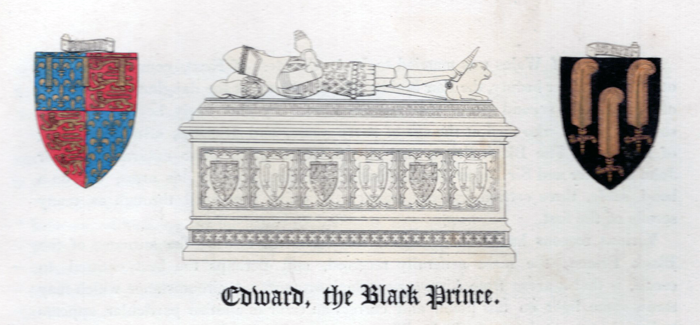 |
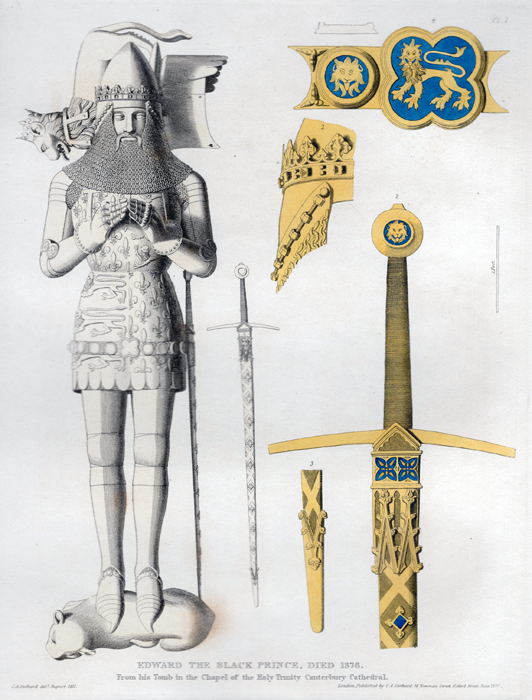
Above and right: Charles
Stothard's drawing and etching of the Black Prince's
monument.
At the very top is a drawing of the gilt bronze
effigy of Edward lying on the tomb chest. To the left is
his arms as the eldest son of King Edward: England
quartered with France with a label indicating the eldest
son. King Edward III, as a grandson of Philippe the
Fair, claimed the throne of France. To the right are his
arms as Prince of Wales.
Above: Stothard's etching of the effigy with
various details.
Right bottom: Side view of the effigy.
Right top: Edward's armour which used to hang
over the tomb but is now displayed in a glass cabinet
nearby. Modern replicas now hang over the tomb.
|
 |
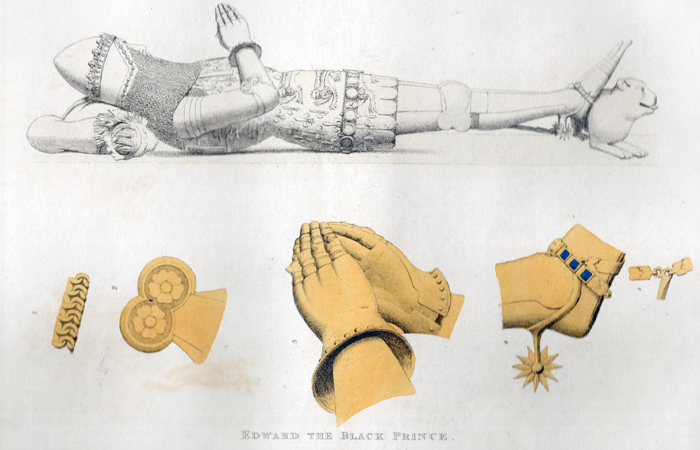 |
Below and right: : Edward
Bore's steel plate engravings of the monument. In
addition we can see the 'tester' hanging over the tomb.
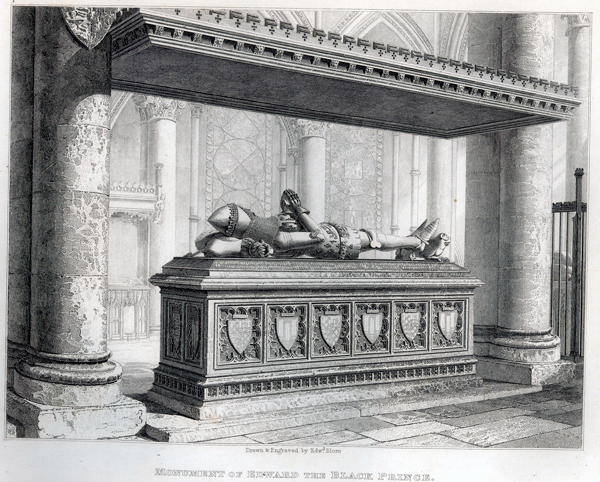 |
 |
|
|
The Black Prince |
Edward of Woodstock (1330-1376)
- known as the 'Black Prince' -1 - was the eldest
son of King Edward III and so heir to the English
throne and well as the English possessions in France; he was
also, in name only, heir to the French throne itself. He became
one of the most successful military commanders in the early part
of the Hundred Years' War. Although born to be king, he
 was not
destined to be so. was not
destined to be so.
In 1333 he was created Earl of Chester and l137 Duke of
Cornwall, which was the first English Dukedom. Then in1343 he
was created Prince of Wales at the age of thirteen.
the age of thirteen.
In 1346 The Black Prince sailed with his father to
France and took part in the
Battle of Crécy, at the age of sixteen. With other
experienced commanders, including Sir John Chandos, he commanded
the
vanguard,
quite unaided by
King Edward
III, who wished his son to gain military
experience both as a soldier and commander. The English were
victorious and Edward, with his father, marched to
Calais and there took part in the year long siege. Calais was to
remain an English foothold in France for many a year. Father
and son then returned to England.
 In 1355 King Edward planned a three pronged attack on France with Prince
Edward, now the King's lieutenant of Gascony,
attacking Aquitaine, although this was no more than a
chevauchée, rather than any major battles being fought. The
Gascons, eager for plunder, were happy to join their English
commander. The following year Prince Edward and his army marched north on
another chevauchée with the intention of linking up, in
Normandy, with his
father and
Charles the Bad, King of
Navarre, at that moment an
ally of the English . However, he was unable to cross
the River Loire so turned west, being flanked by the French army
led by King John
'the Good'. The latter's In 1355 King Edward planned a three pronged attack on France with Prince
Edward, now the King's lieutenant of Gascony,
attacking Aquitaine, although this was no more than a
chevauchée, rather than any major battles being fought. The
Gascons, eager for plunder, were happy to join their English
commander. The following year Prince Edward and his army marched north on
another chevauchée with the intention of linking up, in
Normandy, with his
father and
Charles the Bad, King of
Navarre, at that moment an
ally of the English . However, he was unable to cross
the River Loire so turned west, being flanked by the French army
led by King John
'the Good'. The latter's
 father,
Philip
VI, or Philip of Valois, whose confiscation of King Edward's
French possessions had initiated the whole conflict, had by this
time died. The armies were only a few miles apart. There was
also a detachment of French blocking the English retreat. John
of Gaunt, Edward's brother, attempted to come to Prince Edward's aid
but he too was blocked by the French. father,
Philip
VI, or Philip of Valois, whose confiscation of King Edward's
French possessions had initiated the whole conflict, had by this
time died. The armies were only a few miles apart. There was
also a detachment of French blocking the English retreat. John
of Gaunt, Edward's brother, attempted to come to Prince Edward's aid
but he too was blocked by the French.
.png) When
Prince Edward knew that the larger French army now lay between him and
Poitiers
he set up his position on high ground. Edward was in a much
weaker position and was willing to offer very generous terms to
King John. However the French king was persuaded to demand that
Edward and one hundred of his knights surrender themselves as
prisoner and this Edward would not accept. Negotiations took the
whole day which gave the Prince opportunity to consolidate his
position and for the English army to rest. At daybreak of 19th
September the fighting began and this led to an overwhelming
defeat for the French, King John himself being captured by the
Gascon lord
Captal de Buch. On the
following day Edward and his army continued their march - quite
unmolested - towards Bordeaux. A truce was organized and Prince Edward
left for When
Prince Edward knew that the larger French army now lay between him and
Poitiers
he set up his position on high ground. Edward was in a much
weaker position and was willing to offer very generous terms to
King John. However the French king was persuaded to demand that
Edward and one hundred of his knights surrender themselves as
prisoner and this Edward would not accept. Negotiations took the
whole day which gave the Prince opportunity to consolidate his
position and for the English army to rest. At daybreak of 19th
September the fighting began and this led to an overwhelming
defeat for the French, King John himself being captured by the
Gascon lord
Captal de Buch. On the
following day Edward and his army continued their march - quite
unmolested - towards Bordeaux. A truce was organized and Prince Edward
left for England the following year. England the following year.
In 1359 King Edward and Prince Edward sailed together to Calais
where the Prince led a division during the months long
Rheims
Campaign. This was generally unsuccessful and the two Edwards
were happy to abandon the previous
Treaty of London and negotiate
the
Treaty of Brétigny in which the King abandoned his claim to
the French crown in exchange for Aquitaine, Calais and a few
other territories, but no longer under the overlordship of the
French king. This new treaty was ratified by the two Kings
in 1360 as the Treaty of Calais. The French were also quite
happy to sign the treaty as they were in a weakened position with an
outbreak of civil war in northern France and their own peasant
revolt, know as the
Jacquerie. This appeared to mark the end
of the first phase of the Hundred Years' War.

In 1361 Edward, now thirty, married his
cousin Joan,
known 'The Fair Maid of Kent'. They shared the same grandfather
in King Edward I but Joan 's father had been Edmund of
Woodstock, Earl of
 Kent from whom she had inherited her title of
Countess of Kent, following the death of her brother. She was
now a widow of thirty-two and had three surviving children by her
previous husband. The following year King Edward granted his son
all his dominions in Aquitaine and Gascony -
2
as a principality held by
the Prince - now Prince of Aquitaine and Gascony - from his
father. The following year the Prince, Joan and their households
departed for his new principality Although many lords of his
Aquitaine and Gascony came to pay homage to Prince Edward, many
were unhappy about being handed over to an English overlord;
they were also unhappy about the Prince showing favour to his
own countrymen and his Kent from whom she had inherited her title of
Countess of Kent, following the death of her brother. She was
now a widow of thirty-two and had three surviving children by her
previous husband. The following year King Edward granted his son
all his dominions in Aquitaine and Gascony -
2
as a principality held by
the Prince - now Prince of Aquitaine and Gascony - from his
father. The following year the Prince, Joan and their households
departed for his new principality Although many lords of his
Aquitaine and Gascony came to pay homage to Prince Edward, many
were unhappy about being handed over to an English overlord;
they were also unhappy about the Prince showing favour to his
own countrymen and his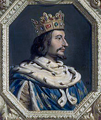 ostentatious extravagance, for the Prince enjoyed the outward
show of his status .
ostentatious extravagance, for the Prince enjoyed the outward
show of his status .
Charles V 'The Wise' came to the French throne, following the death
of his father, John, in 1364. No soldier himself, he was
more than happy to encourage and take advantage of this
dissatisfaction of the lords with the Prince, their immediate
overlord. The free companies - bands of discharged soldiers who
became organized under captains - avaged the countryside as
brigands, robbing, and claiming ransoms and protection money.'Free'
because the owed no loyalty to any government but only to
themselves.
It was noted that the companies - who were largely Englishmen or
Gascons - did not attack the Prince's domain, leading to the
belief that Edward, while not actually encouraging them, did
nothing to discourage them either. In this year King Edward asked
his son,
 seeing the harm being done to all, to restrain their
activities. seeing the harm being done to all, to restrain their
activities.
In 1365 a group of Free Companies took service with
Bertrand du Guesclin, the famous French military leader, who
used them to drive out the legitimate king of
Castile,
Pedro
the Cruel, and set up his bastard brother,
Henry of Trastámara, in his place. Incidentally Pedro was
also, and rather curiously, known as 'The Just'. Pedro and his
four children, being an ally of King Edward, fled to the Black
Prince at Bordeaux. Pedro persuaded Edward to help him recover
this throne and offered to pay Edward, and anyone who would join
him, by dividing his riches when he
had recovered his throne; he also offered to
pay the wages of the army. Pedro and Edward asked Charles the
Bad for permission to take their army across his territory of
Navarre to Castile. Pedro offered to pay Charles and the Prince
lent him the money; the latter was offered territory as a pledge
and this three daughters as hostages for repayment of the debt.
The Prince had borrowed money from his father and broken up his
plate to help pay his men. When the English and Gascon captains
of the free his riches when he
had recovered his throne; he also offered to
pay the wages of the army. Pedro and Edward asked Charles the
Bad for permission to take their army across his territory of
Navarre to Castile. Pedro offered to pay Charles and the Prince
lent him the money; the latter was offered territory as a pledge
and this three daughters as hostages for repayment of the debt.
The Prince had borrowed money from his father and broken up his
plate to help pay his men. When the English and Gascon captains
of the free
 companies
learned that the Black Prince was about to fight for Pedro they withdrew
their support from Henry and joined Edward, whose army consisted
of English and Gascons as well as Bretons and German mercenaries;
there was a civil war in Brittany with the English supporting
the victorious side. The armies met at
Nájera and Henry was defeated and Pedro returned to the
throne. companies
learned that the Black Prince was about to fight for Pedro they withdrew
their support from Henry and joined Edward, whose army consisted
of English and Gascons as well as Bretons and German mercenaries;
there was a civil war in Brittany with the English supporting
the victorious side. The armies met at
Nájera and Henry was defeated and Pedro returned to the
throne.
However this was a pyrrhic victory: Pedro never repaid his debts and
clearly had no intention of doing so as well as refusing to hand over
the promised territories; Pedro soon lost his grip on the throne
and was murdered by his half brother who became know as 'Henry the
Fratricidal'; there was a outbreak of sickness in the
Engish/Gascon army and
many died; the Prince became ill and never fully recovered;
Henry stirred up trouble in Aquitaine; and the French were
angered by the Prince's support for
Pedro against them. John of Gaunt was to marry one of Pedro's
daughters (Constance),
and claim the throne of Castile himself, which was not a wise
decision and would lead to further problems in times to come.

The Battle of
Nájera was to be the final turning
point in the life of Edward, the Black Prince.
Edward on returning encouraged the free companies, who had not been paid
fully, to cross the Loire into French territory to the annoyance
of King Charles who continued to encourage dissatisfaction among
the Gascon lords. The Battle of
Nájera had caused Prince Edward major
financial difficulties: he was unable to fulfill contracts and
introduced a hearth tax which many of his lords refused to
pay. Many such lords took their case to the French
king, who was happy to have this opportunity to request the
Prince's appearance before him in Paris. Edward threw the King's
messenger in jail and replied that yes he would appear but with
an army behind him. By 1367 more than 900 towns and castles had
switched their loyalty to the French King
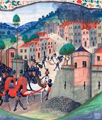 War was declared in 1369 but although desultory at first it weakened the
English hold on the territory. The following year King Charles
raised two large armies for the invasion of Aquitaine and Edward,
in a period of recovery, responded. The French gained many
important cities and the two French armies met to lay siege to Limoges
which was treacherously handed over to them by the Bishop, a
supposed
friend of the Black Prince. Edward, his temper frayed by his illness,
swore they would pay for their treachery. His health had
deteriorated to the extent that he had to be carried to the operations in a
litter. His sappers brought down a section of the walls and the
city was sacked. The Bishop was brought before Edward who was
persuaded the latter's followers not to have him executed as he had wished. The total loss of life
of the
inhabitants was estimated by recent historians as 300: an order of
magnitude less than that originally estimated. So the Black Prince's
famous black mark turns to a shade of gray. Edward's sickness
worsened so he was no longer able to direct further operations. War was declared in 1369 but although desultory at first it weakened the
English hold on the territory. The following year King Charles
raised two large armies for the invasion of Aquitaine and Edward,
in a period of recovery, responded. The French gained many
important cities and the two French armies met to lay siege to Limoges
which was treacherously handed over to them by the Bishop, a
supposed
friend of the Black Prince. Edward, his temper frayed by his illness,
swore they would pay for their treachery. His health had
deteriorated to the extent that he had to be carried to the operations in a
litter. His sappers brought down a section of the walls and the
city was sacked. The Bishop was brought before Edward who was
persuaded the latter's followers not to have him executed as he had wished. The total loss of life
of the
inhabitants was estimated by recent historians as 300: an order of
magnitude less than that originally estimated. So the Black Prince's
famous black mark turns to a shade of gray. Edward's sickness
worsened so he was no longer able to direct further operations.
The death of his eldest son,
Edward
of Angoulême, who was heir to
the throne, from plague at age five,
greatly distressed the Black Prince and his condition
deteriorated to such an extent his physicians advised him to return home
to England, which
he did leaving his brother, John of Gaunt, in charge of
operations. He retired to his estate at Berkhamstead but by
1372 his health had improved sufficiently for he and his father to sail
to France but contrary winds prevented this and it was not to
be. The wheel of fortune had certainly turned against the Black
Prince who now resigned as Prince of Aquitaine and Gascony.
He took part in some political wrangling in in 1376, opposing John of
Gaunt's anti-clerical party and in the
Good Parliament supported
the commons in thier attack on some of the abuses of the
administration. This latter was not supported by John of Gaunt,
who was to reverse the decisions in the
Bad
Parliament the following year. However later
in 1376
the Black Prince's condition
deteriorated considerably and he died at Westminster. So there
was to be no Edward IV or Edward V in the direct Plantagenet
line.
|
-1 Why
the Black Prince? The simple answer to this is that nobody really
knows. The first reference to the term is by John Leland, the
antiquary, writing 160 years after The Black Prince's death. The are a
few theories:.svg.png)
The first of two is that he wore black armour or carried a black shield. The
first of these can be dismissed at once as the Prince fought in
Southern France and Spain. If you have ever touched a black
metal surface heated by the sun you will see why this is highly
unlikely. A black shield is a possibility as he carried a
'shield of peace' during tournaments and this did indeed have a
black background or field in heraldic terms: sable
three ostrich feathers argent. This can be seen on his tomb
alternating with his shield borne as the eldest son of King
Edward III.
The other explanation is a metaphorical one meaning that he had a black reputation and the
French writers do refer to him as 'black'. He was certainly a
very fierce warrior in a time when such ferocity was valued but
I think this origin is rather unlikely.
- 2
Aquitaine, Gascony or Guyenne, and What
about Poitou? History writers discussing this area of France
seem confused about this aspect of their subject so it is hardly surprising
that their
readers will also become confused in the reading. I often find
that when authors seem woolly they - no matter how well respected
they may be -
simply do not know or understand certain aspects of the suject
under discussion. This judgement is
slightly unfair here at least as there is already confusion in
this situation. Eleanor of Aquitaine (also called Eleanor of
Guyene) brought the duchies of Aquitaine as well as Gascony to
the English crown, and the separate County of Poitou. So
Guyenne seems to be a former name of Aquitaine (it is used by Stothard
in his book) and Poitou is a completely separate entity. Guyenne
is said to be a southern French distortion of Aquitaine,
although in English this doesn't bear any resemblance. The
difference between Aquitaine and Gascony has always seemed to
have been ill defined: sometimes the regions overlap, sometimes
Gascony is part of Aquitaine, while sometimes they are two
separate duchies. Gascony is east and south of Bordeaux and was,
and is, occupied by Gascons (hardly surprisingly) who are said
to have a
Basque origin. The native language of the area - Gascon - is
still spoken there, although it is classified as a variation of
Occitan, the language of southern France. Gascony, in general,
sided with the English during the Hundred Years' War and
many joined
the Free Companies with their English counterparts when the
conditions suited them.
It seems that when King Philip Augustus conquered the (so-called)
Angevin Empire from King John, he removed most of Henry II's
French possessions with the exception of Gascony, or at least
the remnants of the Angevin Empire corresponding to that area.
This was still held by the English king as a fief, with the
French King as overlord, a curious situation. As such, it
appears to have been confiscated by the French king and then
restored at intervals. Edward III originally began the Hundred
Year's War in an attempt to recover this area of France from Philip
VI, before actually claiming the crown himself.
|
|
King
Henry IV
Eldest son of John of
Gaunt, Son of King Edward III.
& Queen Joan of Navarre
His second wife |
|
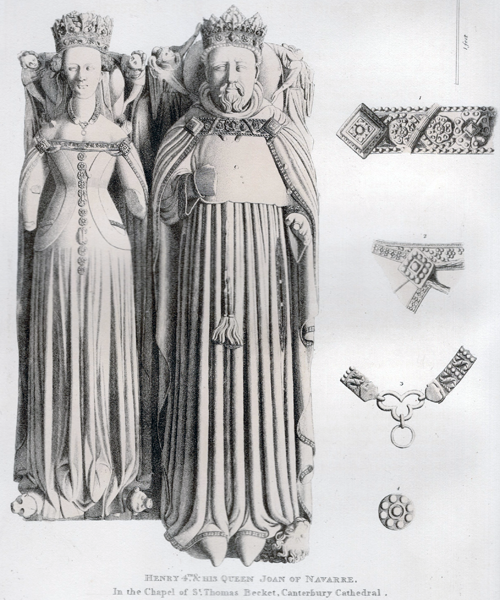
Above and right: The
alabaster effigies of Henry IV and Joan of Navarre, with
details, from the etchings by Charles Stothard.
The effigies are attributed to
Robert Brown 1437
Below:The monument from steel plate engravings by
Edward Blore. On the left we see the effigies again but
with the surrounding structure and the gablettes over
the heads. To the right is the whole monument with tomb
chest, which probably held figures in the niches, and
the tester over the monument. |
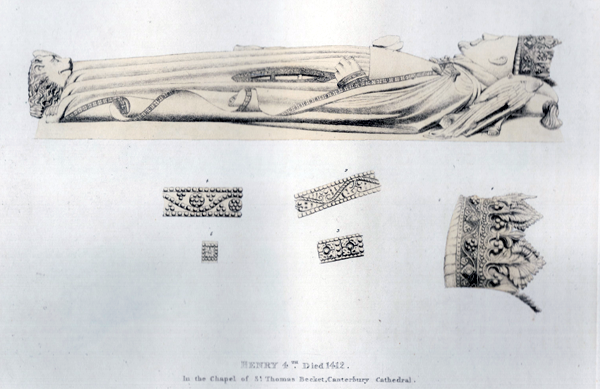 |
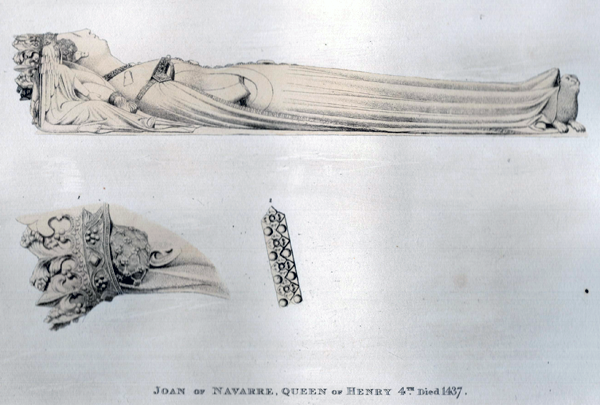 |
|
| King Henry IV |
Years ago I was in Canterbury Cathedral
looking at the tomb of Henry IV, when a mother and her
child wandered by, the mother telling the child that this was
the king who had six wives. Apart from those monarchs who
had very short or rather obscure reigns, Henry IV must be
England's least known king. This may be because while television, cinema and popular culture tells us
endlessly about the Henry who did have six wives, the
fourth of that name is mostly ignored, so residing in obscurity.
He had two wives, by the way, but neither met such contraversial ends. On
another level the English Monarch Series, books
published initially by Methuen, then later by Yale, began in 1964
but Henry IV had to wait until 2016 to appear, more than
fifty years later. I find this rather curious as Henry IV
had a relatively short reign to study but a very eventful one.
Henry of Bolingbroke, as he was, was not destined to be king: he was
born in Bolingbroke Castle, Lincolnshire in 1367, the eldest son of
John of Gaunt, himself the fourth son of King Edward III, and
his first wife, Blanche of Lancaster. Blanche was the
younger daughter of Henry Grosmont, 1st Duke of Lancaster,
himself the great-grandson of King Henry III, and it is from
Blanche that John of Gaunt inherited his land and titles, her
elder sister having died before her.
Henry was one of the junior Lords Appellant who attempted, and
for a time succeeded, to control the arbitrary and tyrannical government
of King Richard II. John of Gaunt, the King's uncle, helped
Richard slowly regain power when the former returned from his
adventures abroad; Richard set out to punish the Lords Appellant:
the Duke of Gloucester, his uncle, was murdered, the Earl of Arundel
executed and the Earl of Warwick banished. Thomas Mowbray, Duke
of Norfolk, one of the Junior Appellants like Henry, regained
the King's favour and, it is said that on Richard's orders,
organized the murder of the Duke of Gloucester. Henry was left
alone by the King at least initially.
A dispute occurred between Henry and Thomas Mowbray and they
appeared before King Richard. This dispute is obscure, to me
anyway, but it may
have been related to the murder of the Duke of Gloucester. The
King ordered that the dispute be settled by Trial by Battle but
then cancelled this order and banished them both. Thomas Mowbray
died in exile so never returned to England. Henry lived although
while he was in exile his father, John of Gaunt, died
whereupon King Richard, both spitefully and foolishly, seized his
vast
lands, which, of course, were Henry's inheritance.
After consultation with
Thomas Arundel, the former Archbishop of
Canterbury, who had also been exiled by Richard because of his
association with the Lords Appellant, Henry returned to England
landing at Ravenspur in Yorkshire, with Arundel as his adviser.
While Richard was campaigning in Ireland, Henry began a military campaign initially announcing
that he had returned to claim the Lancaster inheritances, but he
gathered enough support to then announce that he was claiming
the crown. Richard returned from Ireland and surrendered at Fint
in North Wales where he was forced to abdicate; he was then was imprisoned in
Pontefract castle. Henry's main supporters on this campaign were
Arundel himself, whom Henry was to reinstate as Archbishop of
Canterbury, and
Henry Percy, 1st Earl of Northumberland who was
later
to prove treacherous.
Henry Bolingbroke was crowned as King Henry IV by Thomas Arundel in
Westminster Abbey on 13th October 1399, a year to the day since he had
been sent into exile, and
the line of the Lancastrian Kings began. However it was not to
be a happy reign as will be seen.
Almost immediately in January 1400 there was a rebellion (known as the
Epiphany Rising), by the Earls of
Huntingdon (half brother to Richard),
Kent
(nephew of Huntingdon) and
Salisbury, which
planned to murder Henry as well as the Archbishop of
Canterbury and Henry's four sons
and then return Richard to the throne. Others involved were
Baron Despenser,
Earl of Rutland (Edward of Norwich),
Baron Lumley, and
Sir Bernard Brocas. Also included because he resembled
Richard and could impersonate him was an esquire, Richard
Maudeleyn. They plotted at the home of the Abbot of Westminster
to seize the King at a tournament, kill him and restore Richard
to the Throne. However they were betrayed by one of the
conspirators - the Earl of Rutland - and Henry acted quickly.
The rebels had expected that the whole country would rise in
favour of Richard but the opposite proved to be the case.
Salisbury and Kent were captured by a local authority, tried and
executed; Despenser captured by the crew of a ship he attempted
to flee in and executed as elsewhere and separately were Huntingdon and Lumley. Brocas was
tried in London and executed as was Maudeleyn. The Abbot was
imprisoned in the Tower but soon released. In all twenty-six
were beheaded, six were hanged, drawn and quartered, but many
were pardoned.
There were to be no more attempts to return Richard since he
died in prison in February 1400 shortly after the rising. No one
know how he died: there were said to be no marks of
violence on his remains when examined in the nineteenth century
but this examination neither proves nor disproves a non violent
end. It is said the he may starved himself to death from grief
at the failure of the Epiphany Plot or have been deliberately
staved by his jailors. Whether Henry ordered or had knowledge of
this is unknown and must remain another medieval mystery.
The revolt of
Owain Glyndŵr began in
September the same year and this rebellion was to be prolonged
with many failed attempts at his defeat. He was so successful
that he declared himself Prince of Wales in 1404. The
following year things began to falter, his being defeated by John
Talbot and a month later by Prince Henry. However the rebellion
did not finally collapse until 1409.
During the nine years of the Glyndŵr revolt the rebellion of Henry Percy, 1st Earl of Northumberland,
occurred in 1403, ending with the
Battle of
Shrewsbury where both Henry and his eldest son
(the future Henry V) fought the rebels. The younger Henry was
badly wounded and the Earl's son, another Henry, but
conveniently known as Hotspur, was killed. Why this treachery
by the Earl? The Perceys had
fought against the invading Scots at the
Battle of Homildon Hill, where the Scots were thoroughly routed
and many noble prisoners were taken. However, King Henry would not allow
them to be ransomed as he did not wish them to lead another army
into England. This did not please the Earl as ransoming
prisoners was a good source of income, so the Earl decided to
challenge Henry, supporting the Glyndŵr rebellion and linking up
with
Edmund Mortimer, 5th Earl of March. This Edmund Mortimer was
son of Roger Mortimer, the 4th Earl, and thus descended - albeit
via the female line - from an older son of King Edward III
(Lionel, Duke of Clarence) than John of Gaunt; Roger
Mortimer had been vaguely recognized as heir to the throne by
the childless Richard II, ignoring the usual rules of succession
which had been laid down by Edward III. When we include Edmund's
sister into all of this it becomes wonderfully complicated but
that's another story and not relevant here. King Henry did not
charge the Earl with treason as the latter did not personally
take part in the rebellion.
In 1405, again during the Glyndŵr rebellion, there was yet
another Percy rebellion. This was led
by
Thomas Mowbray, 4th Earl of Norfolk (the son of another
Thomas, 3rd Earl and 4th Duke, who had been banished with Henry)
and
Richard Scrope, Archbishop of York. The rebels were
abandoned by the Earl of Northumberland and overcome by the
King's army led by his son, John of Lancaster, and The Earl of
Westmoreland, at Shipton Moor. The judge refused to pass sentence on the leaders
of the rebellion unless they were tried by their peers, so
Henry, probably weary of these rebellions, had them summarily
executed. The Earl fled to Scotland.
When the Glyndŵr rebellion still in progress, in 1408, Earl Henry
Percy invaded England from his exile in Scotland with an army of
Lowland Scots to be met with an army of Yorkshire levies led by
High Sherriff
Sir
Thomas Rokeby at
Battle of Branham Moor. Again the rebel army was scattered
and many killed including the troublesome Earl. The power of the
Perceys in the north was broken, at least
temporarily.
Henry was affected by bouts of incapacitating illness in the last
years of his reign and from 1406 did not act as an effective ruler.
It is difficult to diagnose illnesses from centuries ago and by
the descriptions given by physicians of the time. It was said to
be leprosy sent as a punishment for his usurping the throne,
possible regicide and his execution of Archbishop Scrope. The
symptoms sound like he possibly suffered from
arthritic psoriasis, an auto-immune disease which
includes skin lesions and difficulty with and pain in the
joints, and which becomes increasingly disabling as it
progresses; there are also remissions and exacerbations. There
may well also be a inherited factor.
He died in 1410 at the age of forty-seven.
He married as his first wife
Mary Bohun,
joint heiress with her sister of the substantial estates o f
Humphrey de Bohun, Earl of Hereford. She was the mother of Henry V as well as three other
sons and two daughters. Unfortunately Mary died at
twenty-six giving birth to her last daughter, Phillippa, and did
not live to see her eldest son become king.
Henry's second wife was
Joanne of Navarre, daughter of King Charles
the Bad, who had changed sides several times during the Hundred
Years' War under Edward III. Her first husband was
John IV, Duke of Brittany by whom she had four sons and five
daughters. She and Henry had met while Henry was in exile and
they married in 1403 after Henry had became king. She bore Henry IV no children
but may have given birth to two still born babies.
Henry V had a good relationship with his stepmother and she even
acted as regent during his absence in France. However when Henry
V brought back as a prisoner her son, Arthur of Brittany, the
relationship broke down and Joanne was accused of trying to
kill the King by, it appears, witchcraft. She was never tried
but imprisoned in
1419 and all her lands and possessions confiscated. However her
stepson released her and restored the confiscations before he died in
1422
|
| |
|
|
The South Ambulatory |
|
Archbishop Hubert Walter |
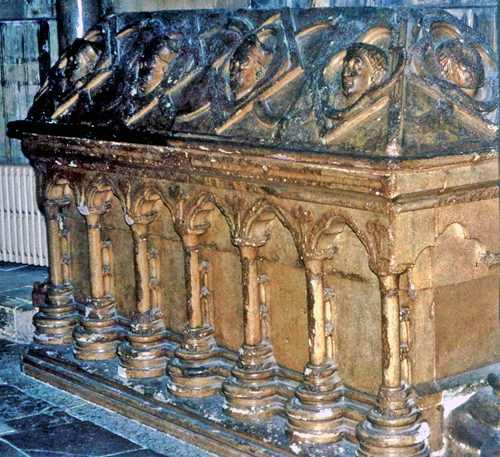 Hubert
Walter (c. 1160-1205) was a cleric and
administrator under kings
Henry II,
Richard I and
John. Although neither a holy nor learned man he
became one of the most outstanding government
administrators of the middle ages. Hubert
Walter (c. 1160-1205) was a cleric and
administrator under kings
Henry II,
Richard I and
John. Although neither a holy nor learned man he
became one of the most outstanding government
administrators of the middle ages.
He was aided in this career by his uncle,
Ranulf Glanvill, who was
chief
justiciar under Henry II.
During the reign of Henry II Hubert was appointed Dean
of York, having been an unsuccessful candidate for the
post of Archbishop. He was then was appointed Bishop of Salisbury after Richard became king
in 1189
and then accompanied Richard on the
Third Crusade, departing before the King from
Marseille together with
Baldwin of Forde (Archbishop of Canterbury) and
Ranulf Glanvill, both of whom were to die during
the Siege of Acre. He acted as a principal negotiator with
Saladin
even persuading the latter to allow a few Western
clerics to remain in Jerusalem to hold Christian
services..
Hubert learned in Sicily on his way home from the Holy Land that King
Richard had been captured on his way home and was held
by the Holy Roman Emperor,
Henry VI. He was one of the first to find the
King and was one of those involved in raising the ransom
demanded by the Emperor. As a reward for
these services King Richard wrote to
Queen Eleanor asking her to arrange Hubert's
appointment as Archbishop of Canterbury, the last
incumbent (Baldwin) having died, as mentioned above, in
the Holy Land. He was also appointed chief justiciar; in
this position he effected a number of important legal
reforms some of which are the basis of the English legal
system today, such as the appointment of Justices of the
Peace. He resigned his secular posts in 1198.
He had, not without difficulty, forced Prince John to
submit after he rebelled against his imprisoned brother
Richard using both secular (a siege) and ecclesiastical
powers (excommunication) to effect John's submission.
After the sudden death of King Richard, Hubert supported
John succession against the rival candidate for
the crown,
Arthur I, Duke of Brittany who was the son of
Richard and John's long dead elder brother,
Geoffrey. John's claim was successful and he was
crowned by Hubert in Westminster Abbey in 1199. As a
reward for his services the king appointed Hubert
Chancellor of England, a senior administrative
secular post. Hubert was also employed by John on a
number of diplomatic missions.
Hubert died in 1205 after a long illness.
|
| Above:
Archbishop Hubert Walter (1205).
Purbeck Marble |
|
|




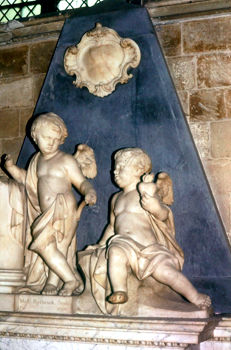
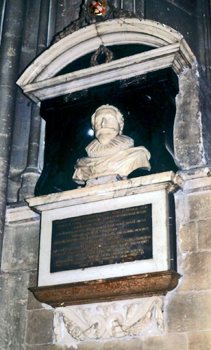
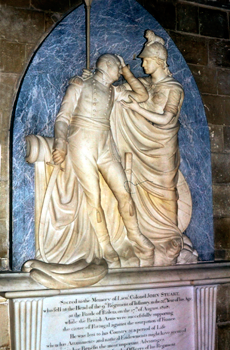
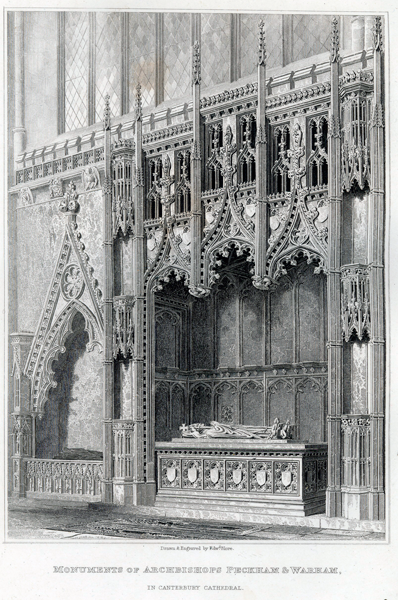


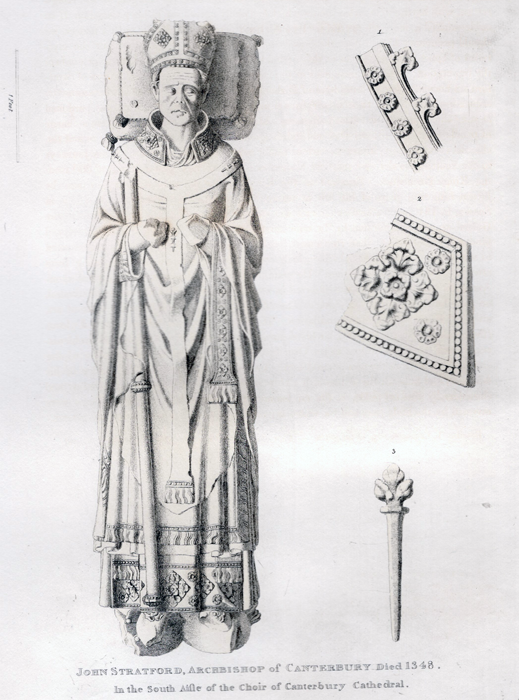
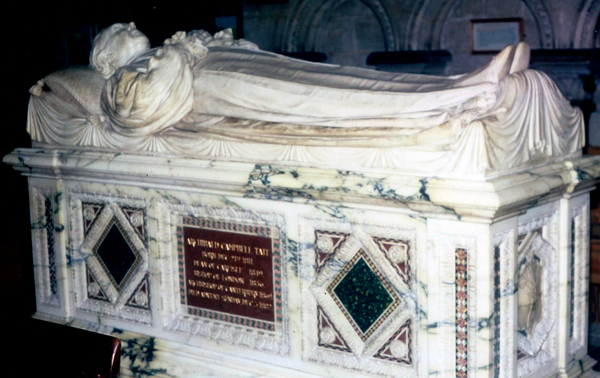




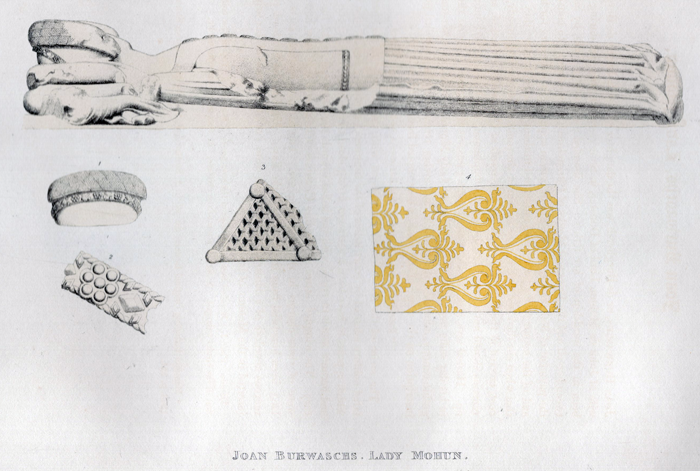

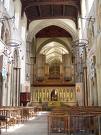


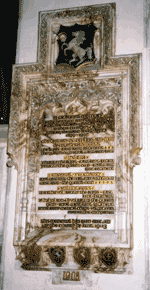
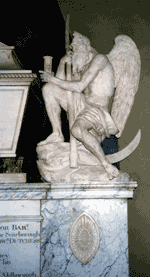

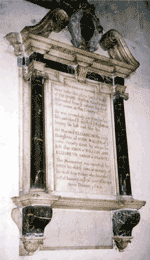
.gif)
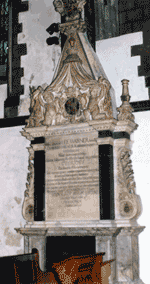





 was not
destined to be so.
was not
destined to be so. the age of thirteen.
the age of thirteen. In 1355 King Edward planned a three pronged attack on France with Prince
Edward, now the King's lieutenant of Gascony,
attacking Aquitaine, although this was no more than a
In 1355 King Edward planned a three pronged attack on France with Prince
Edward, now the King's lieutenant of Gascony,
attacking Aquitaine, although this was no more than a
 father,
father,
.png) When
Prince Edward knew that the larger French army now lay between him and
When
Prince Edward knew that the larger French army now lay between him and
 England the following year.
England the following year.
 Kent from whom she had inherited her title of
Countess of Kent, following the death of her brother. She was
now a widow of thirty-two and had three surviving children by her
previous husband. The following year King Edward granted his son
all his dominions in Aquitaine and Gascony -
Kent from whom she had inherited her title of
Countess of Kent, following the death of her brother. She was
now a widow of thirty-two and had three surviving children by her
previous husband. The following year King Edward granted his son
all his dominions in Aquitaine and Gascony - ostentatious extravagance, for the Prince enjoyed the outward
show of his status .
ostentatious extravagance, for the Prince enjoyed the outward
show of his status . seeing the harm being done to all, to restrain their
activities.
seeing the harm being done to all, to restrain their
activities. his riches when he
had recovered his throne; he also offered to
pay the wages of the army. Pedro and Edward asked Charles the
Bad for permission to take their army across his territory of
Navarre to Castile. Pedro offered to pay Charles and the Prince
lent him the money; the latter was offered territory as a pledge
and this three daughters as hostages for repayment of the debt.
The Prince had borrowed money from his father and broken up his
plate to help pay his men. When the English and Gascon captains
of the free
his riches when he
had recovered his throne; he also offered to
pay the wages of the army. Pedro and Edward asked Charles the
Bad for permission to take their army across his territory of
Navarre to Castile. Pedro offered to pay Charles and the Prince
lent him the money; the latter was offered territory as a pledge
and this three daughters as hostages for repayment of the debt.
The Prince had borrowed money from his father and broken up his
plate to help pay his men. When the English and Gascon captains
of the free
 companies
learned that the Black Prince was about to fight for Pedro they withdrew
their support from Henry and joined Edward, whose army consisted
of English and Gascons as well as Bretons and German mercenaries;
there was a civil war in Brittany with the English supporting
the victorious side. The armies met at
companies
learned that the Black Prince was about to fight for Pedro they withdrew
their support from Henry and joined Edward, whose army consisted
of English and Gascons as well as Bretons and German mercenaries;
there was a civil war in Brittany with the English supporting
the victorious side. The armies met at

 War was declared in 1369 but although desultory at first it weakened the
English hold on the territory. The following year King Charles
raised two large armies for the invasion of Aquitaine and Edward,
in a period of recovery, responded. The French gained many
important cities and the two French armies met to lay siege to Limoges
which was treacherously handed over to them by the Bishop, a
supposed
friend of the Black Prince. Edward, his temper frayed by his illness,
swore they would pay for their treachery. His health had
deteriorated to the extent that he had to be carried to the operations in a
litter. His sappers brought down a section of the walls and the
city was sacked. The Bishop was brought before Edward who was
persuaded the latter's followers not to have him executed as he had wished. The total loss of life
of the
inhabitants was estimated by recent historians as 300: an order of
magnitude less than that originally estimated. So the Black Prince's
famous black mark turns to a shade of gray. Edward's sickness
worsened so he was no longer able to direct further operations.
War was declared in 1369 but although desultory at first it weakened the
English hold on the territory. The following year King Charles
raised two large armies for the invasion of Aquitaine and Edward,
in a period of recovery, responded. The French gained many
important cities and the two French armies met to lay siege to Limoges
which was treacherously handed over to them by the Bishop, a
supposed
friend of the Black Prince. Edward, his temper frayed by his illness,
swore they would pay for their treachery. His health had
deteriorated to the extent that he had to be carried to the operations in a
litter. His sappers brought down a section of the walls and the
city was sacked. The Bishop was brought before Edward who was
persuaded the latter's followers not to have him executed as he had wished. The total loss of life
of the
inhabitants was estimated by recent historians as 300: an order of
magnitude less than that originally estimated. So the Black Prince's
famous black mark turns to a shade of gray. Edward's sickness
worsened so he was no longer able to direct further operations..svg.png)



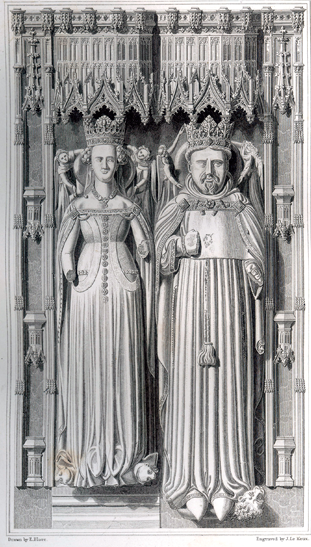
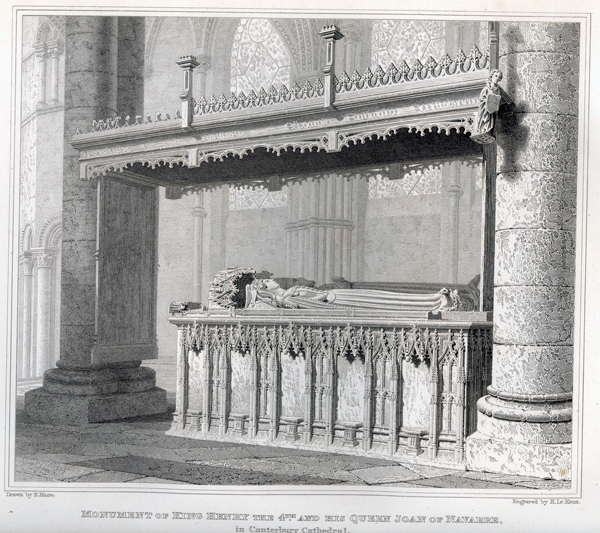

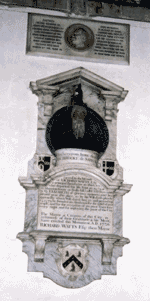
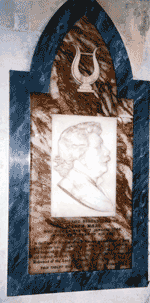

.png)